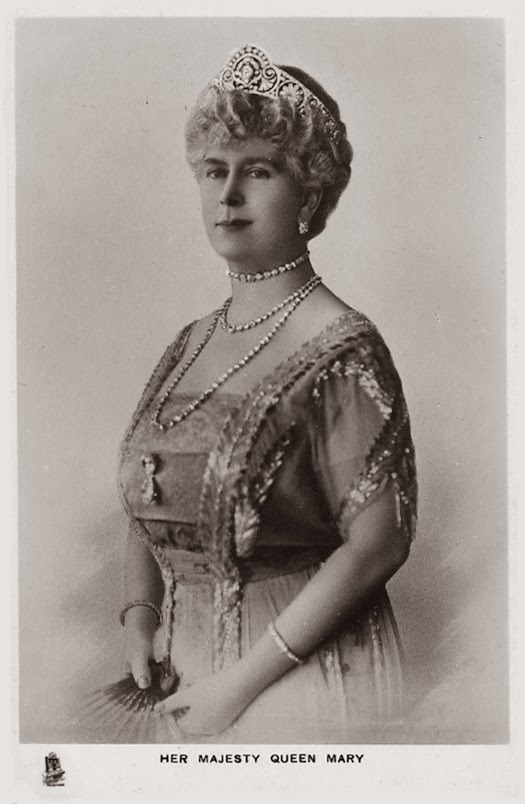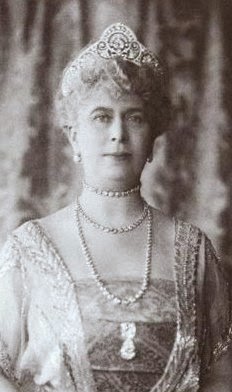Queen Mary’s Honeysuckle Tiara
Happy birthday to our Magpie of the Month (and, really, the patron saint of royal jewels), Queen Mary! Her Serene Highness Princess Victoria Mary of Teck was born on May 26, 1867. Even though she was technically a German princess (her father was the Duke of Teck, who was a sort-of member of the royal family of Württemberg), her mother was a British princess, and May was born in Kensington Palace. And we all know what her ultimate fate was: she was the wife of one king and the mother of two more, and the jewelry worn today by members of the British royal family would look a lot different had she not had her royal paws on the collection.
 |
| Mary wears the original version of the honeysuckle tiara for a postcard portrait [1] |
Today, we’re looking at our last spotlight piece (for this month, anyway) from Mary’s own collection: her diamond honeysuckle tiara. The provenance of this tiara was a bit fuzzy for years. Some thought the piece was one of the items that came from the estate of Tsarina Marie Feodorovna of Russia (sister of Queen Alexandra). But although the piece does resemble some Romanov tiaras, that wasn’t the case. It was actually commissioned by Mary herself shortly after she became queen.
 |
| Mary wears the taller original version of the tiara [2] |
The tiara was made by E. Wolff & Co. on a commission from Garrard. Wolff & Co. also made several other major tiaras for the family, including the Cambridge Lover’s Knot, the Girls of Great Britain and Ireland, and the Connaught Diamond (now a part of the Bernadotte collection in Sweden). The original version of the honeysuckle tiara, completed in early 1914, featured a taller central element; Mary later had it shortened to its current iteration. The tiara also used some recycled royal diamonds, taken from the County of Surrey Tiara, which had been dismantled (and also used in the remodeling of the GGB&I Tiara).
The tiara has been an adaptable piece from the start, as the central element of the tiara is able to accommodate several different stones. Originally, it was designed to fit three different pieces: the Cullinan V diamond, a sapphire and diamond ornament, and a diamond element featuring a pink stone. That pink gemstone has been called a pink topaz, but it seems actually to be a kunzite, a stone that had been discovered only a decade before the tiara was made.
But although the tiara could be worn in so many different configurations, Mary didn’t really keep it all that long. In 1935, she offered the tiara to her new daughter-in-law, Lady Alice Montagu Douglas Scott, when she married Prince Henry, Duke of Gloucester. But before Mary gave the tiara away, she had a new diamond piece, which also features a honeysuckle design motif, created to fit the tiara’s central space. (You can see that extra diamond piece in the tiara, worn by the current Duchess of Gloucester, in the photo above.)
The Cullinan V, the sapphire, and the kunzite stayed with Mary, while the new diamond honeysuckle piece was given to Alice along with the tiara. In 1953, Alice inherited the kunzite element following Mary’s death. Exactly where the current third option, an emerald and diamond piece, comes into the picture is unclear, but those three — the honeysuckle, the kunzite, and the emerald — are the ones that remain with the tiara today.
Princess Alice eventually gave the tiara to her own daughter-in-law, Birgitte (the current Duchess of Gloucester), who has worn the sparkler in all of its forms for a number of years. Having the central element as a convertible piece is especially useful because it means the tiara can be coordinated with different colors of gala dresses; if you’re worried that your kunzite tiara will clash with your red gown, you can always swap it out. I do love when a tiara pulls its weight! And apparently, so does Birgitte. Even though she’s a bit spoiled for choice, with six tiaras (yes, six!) in her collection [3], the honeysuckle is the piece that she’s photographed in most often [4].
NOTES, PHOTO CREDITS, AND LINKS
1. Image in the public domain due to age; source here.
2. Cropped version of an image in the public domain due to age; source here.
3. Because I know someone will ask, the six tiaras owned by the Duke and Duchess of Gloucester are: Queen Mary’s honeysuckle tiara, Princess Marie Louise’s Indian-inspired Cartier tiara, Queen Mary’s Iveagh tiara, Queen Mary’s turquoise tiara, Princess Alice’s emerald and diamond tiara, and the all-diamond tiara last seen as a bridal tiara on the Countess of Ulster.
4. A version of this post originally appeared at A Tiara a Day in August 2013.
Sunday Sparkler: The Oriental Circlet Tiara
Yesterday, Queen Victoria celebrated her — ahem — 195th birthday. To mark the occasion, today we’re looking at one of the most important Victorian tiaras in the Windsor collection: Victoria’s Oriental Circlet.
In terms of royal provenance, it doesn’t get much better than this tiara. It was not only worn by Queen Victoria but also designed by her beloved Albert, and it’s the only one of the four tiaras designed by Albert that is still owned by the main branch of the British royal family [1]. The piece, which includes arches and lotus flowers inspired by eastern designs, was dreamed up by the Prince Consort after he saw jewels featuring similar motifs at the Great Exhibition, the landmark event that proved to be perhaps his greatest royal legacy. The Royal Collection’s website notes that Albert “had been greatly impressed by the Indian jewels presented to the Queen by the East India Company at the conclusion of the Great Exhibition” [2]. The Moghul arches and lotus flower designs in the circlet were inspired by those jewels.
Garrard executed Albert’s design in 1853. This original incarnation of the tiara had opals set in the center of the lotus elements — opals were a particular favorite of Albert’s. The diamonds used to make the tiara were taken from the family’s collection, which caused a problem shortly after the piece’s construction. The Hanoverian branch of the family won the legal right to the late Queen Charlotte’s jewels in 1858, and a significant number of the diamonds in the tiara had to be sent to Germany. They were removed and replaced with other diamonds, some newly acquired and some taken from other royal jewels.
Victoria had little use for elaborate tiaras, including this piece, after Albert’s death in 1861. When she died forty years later, the tiara was left to the crown and specifically earmarked for the use of future queens and queens consort. The next in line to wear the tiara, then, was Victoria’s daughter-in-law, Queen Alexandra. She didn’t share Albert’s fondness for opals — in fact, she thought they were bad luck — and so she had the center stones replaced with rubies. The rubies had been in the family’s vaults nearly as long as the tiara, and they had a real connection to the eastern reaches of the empire: they were Burmese rubies that had been given to Victoria in the 1870s. Alexandra also had the size of the circlet reduced slightly.
Oddly enough, however, neither Alexandra nor her tiara-loving successor, Queen Mary, were apparently ever photographed wearing the tiara, even after Alexandra took such pains to remodel it. I’ve often wondered whether Mary just never found the tiara in the vaults — it seems totally impossible that she would ignore a major tiara while constantly making and remaking the rest of the pieces in the family collection. We may never know precisely why it escaped her magpie gaze.
The next British queen to don the tiara was Mary’s daughter-in-law, Queen Elizabeth (better known to us as the Queen Mum). The tiara was made available to her in 1937, the year that her husband, George VI, was crowned king. It became one of her most-worn pieces; she was still using the circlet in her old age, even though her daughter had been queen for nearly half a century. Even though it was a part of the collection of jewels that should have been transferred from the Queen Mum to the new Elizabeth II in 1952, the Queen allowed her mother to continue to use the favorite piece. Along with the Boucheron tiara from the Greville inheritance, it was the only tiara that the Queen Mum wore in her later years.
The tiara was given a place of honor at the major tiara exhibition put on by the Victoria & Albert Museum in London shortly before the Queen Mum’s death [3]. Since then, the tiara has been worn in public precisely once. Elizabeth II chose it for a state visit to Malta in 2005 (pictured above), three years after her mother’s death. She has not been photographed in the tiara since that occasion. Perhaps its sentimental associations with her late mother are simply too much? Maybe she just doesn’t like wearing it?
No matter the reason, it’s become increasingly possible that the tiara may once more wait in the vaults for a new queen to wear it. I have a sneaking feeling that (unless Angela Kelly has one of her many jewelry surprises up her sleeve for us) we’ll next see this tiara on the head of King Charles’s consort, whether she be called Queen or Princess Camilla [4].
NOTES, PHOTO CREDITS, AND LINKS
1. The other tiaras designed by Albert for Victoria are: the strawberry leaf tiara given to Princess Alice as a wedding gift in 1862 (it survived the Hesse plane crash of 1937); the small sapphire coronet (owned today by the Harewoods, descendants of Princess Mary); and the emerald and diamond tiara (which, if it is still intact, may be owned today by the Carnegies, descendants of Princess Louise).
2. See the Royal Collection website here.
3. It was also exhibited at Buckingham Palace in 2010 as a part of “Victoria & Albert: Art and Love.”
4. A version of this post originally appeared at A Tiara a Day in July 2013.